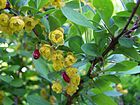Note: This is a project under development. The articles on this wiki are just being initiated and broadly incomplete. You can Help creating new pages.
Difference between revisions of "Berberis vulgaris - Daruharidra"
(→References) |
(→External Links) |
||
| Line 75: | Line 75: | ||
==External Links== | ==External Links== | ||
| − | * [http://www.homeremediess.com/berberis-vulgaris-barberry-plant-images-medicinal-uses/] | + | * [http://www.homeremediess.com/berberis-vulgaris-barberry-plant-images-medicinal-uses/ Berberis Vulgaris (Barberry) Plant Images & Medicinal Uses] |
| − | * [https://www.ncbi.nlm.nih.gov/pubmed/18618524] | + | * [https://www.ncbi.nlm.nih.gov/pubmed/18618524 Pharmacological and therapeutic effects of Berberis vulgaris and its active constituent, berberine] |
| − | * [https://onlinelibrary.wiley.com/doi/abs/10.1002/ptr.2399] | + | * [https://onlinelibrary.wiley.com/doi/abs/10.1002/ptr.2399 Pharmacological and therapeutic effects of Berberis vulgaris and its active constituent, berberine] |
| − | * [https://www.researchgate.net/publication/5233136_Pharmacological_and_therapeutic_effects_of_Berberis_vulgaris_and_its_active_constituent_berberine] | + | * [https://www.researchgate.net/publication/5233136_Pharmacological_and_therapeutic_effects_of_Berberis_vulgaris_and_its_active_constituent_berberine Pharmacological and therapeutic effects of Berberis vulgaris and its active constituent] |
| − | * [https://www.hindawi.com/journals/aps/2018/3018498/] | + | * [https://www.hindawi.com/journals/aps/2018/3018498/ Studies on the Dual Cytotoxicity and Antioxidant Properties of Berberis vulgaris] |
[[Category:Herbs]] | [[Category:Herbs]] | ||
Revision as of 17:48, 4 May 2018
Berberis vulgaris also known as common barberry, European barberry or simply barberry, is a shrub in the genus Berberis. It is native to the Himalayas in India and in Nepal. It is also naturally found in the wet zone of Sri Lanka.
Contents
Uses
Cancer, Malarea, gallbladder pain, gallstones, jaundice, stomach ulcer, mouth bacterial dysentery.
Parts Used
Chemical Composition
Extracts from the inner stem bark of Berberis vulgaris were analyzed for their antioxidant activity using the 1,1-dipheny-2-picrylhydrazyl (DPPH) method and compared with ascorbic acid (AA) and butylated hydroxytoluene (BHT)[1]
Common names
| Language | Common name |
|---|---|
| Kannada | |
| Hindi | |
| Malayalam | |
| Tamil | |
| Telugu | |
| Marathi | NA |
| Gujarathi | NA |
| Punjabi | NA |
| Kashmiri | NA |
| Sanskrit | |
| English | Agrimony |
Habit
Identification
Leaf
| Kind | Shape | Feature |
|---|---|---|
| Simple | oval | Leavesare 0.75-2 in. (2-5 cm) long, 0.25-0.75 in. (1-2 cm) wide, serrate and occur in clusters of 2-5. Each cluster of leaves is subtended by a short, three-branched spine |
Flower
| Type | Size | Color and composition | Stamen | More information |
|---|---|---|---|---|
| Unisexual | less than 0.25 in. (6 mm) wide | yellow | 5-20 | Flowering occurs in May to June and The flowers have an unpleasant odor |
Fruit
| Type | Size | Mass | Appearance | Seeds | More information |
|---|---|---|---|---|---|
| ellipsoids | 0.3 in. (10 mm)7–10 mm (0.28–0.4 in.) long pome | contain 1-3 small black seeds. The fruit is dispersed by birds and other wildlife | With hooked hairs | {{{6}}} |
Other features
List of Ayurvedic medicine in which the herb is used
- Vishatinduka Taila as root juice extract
Where to get the saplings
Mode of Propagation
How to plant/cultivate
Prefers a warm moist loamy soil but it is by no means fastidious, succeeding in thin, dry and shallow soils[11, 200]. Prefers a light rich rather dry soil according to another repor[3]
Commonly seen growing in areas
Abandoned Field, Coastal Grassland, Early Successional Forest.
Photo Gallery
References
External Links
- Berberis Vulgaris (Barberry) Plant Images & Medicinal Uses
- Pharmacological and therapeutic effects of Berberis vulgaris and its active constituent, berberine
- Pharmacological and therapeutic effects of Berberis vulgaris and its active constituent, berberine
- Pharmacological and therapeutic effects of Berberis vulgaris and its active constituent
- Studies on the Dual Cytotoxicity and Antioxidant Properties of Berberis vulgaris
- Pages that are stubs
- Ayurvedic Herbs known to be helpful to treat Cancer
- Ayurvedic Herbs known to be helpful to treat Malarea
- Ayurvedic Herbs known to be helpful to treat gallbladder pain
- Ayurvedic Herbs known to be helpful to treat gallstones
- Ayurvedic Herbs known to be helpful to treat jaundice
- Ayurvedic Herbs known to be helpful to treat stomach ulcer
- Ayurvedic Herbs known to be helpful to treat mouth bacterial dysentery
- Herbs with Stem used in medicine
- Herbs with Root used in medicine
- Herbs with Fruit used in medicine
- Herbs with common name in English
- Habit - Herb
- Index of Plants which can be propagated by Seeds
- Index of Plants which can be propagated by Cuttings
- Herbs that are commonly seen in the region of Abandoned Field
- Herbs that are commonly seen in the region of Coastal Grassland
- Herbs that are commonly seen in the region of Early Successional Forest
- Herbs











